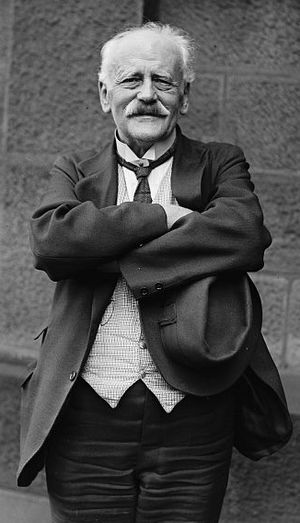Otto Stapf (botanist) facts for kids
Quick facts for kids
Otto Stapf
|
|
|---|---|
 |
|
| Born | 23 March 1857 Perneck near Bad Ischl
|
| Died | 3 August 1933 (aged 76) |
| Awards | Linnean Medal (1927) Fellow of the Royal Society |
| Scientific career | |
| Institutions | Royal Botanic Gardens, Kew |
Otto Stapf (born April 23, 1857, died August 3, 1933) was an important Austrian botanist and taxonomist. A botanist studies plants, and a taxonomist names and classifies them.
Otto's father, Joseph Stapf, worked in the salt mines of Hallstatt. Otto grew up there and later wrote about ancient plant remains. These plant pieces were found in the Late Bronze and Iron Age mines by his father.
Contents
Early Life and Studies
Otto Stapf studied botany in Vienna, Austria. His teacher was Julius Wiesner. Otto earned his PhD by studying crystals inside plants.
In 1882, he became an assistant professor to Anton Kerner von Marilaun. By 1887, he was a lecturer in Vienna. He helped publish findings from other explorers. These included plants collected in Lycia and Mesopotamia by Felix von Luschan.
Expedition to Persia
In 1885, Otto Stapf went on his own plant-finding trip. He explored South and Western Persia (modern-day Iran). This trip lasted nine months and was sponsored by Jakob Eduard Polak. Polak was the personal doctor to the Shah of Persia.
During this expedition, Otto discovered many new plant species. He began to publish his findings, including a beautiful flower called Iris meda.
Moving to Kew Gardens
After his trip, Otto Stapf faced some difficulties with his boss, Anton Kerner. There were rumors that Kerner wanted Otto's job for someone else. Kerner also questioned Otto's identification of the plants he collected.
Because of this, Otto Stapf moved to the Royal Botanic Gardens, Kew in England in 1890. He became a British citizen in 1905. From 1909 to 1920, he was the keeper of the Herbarium at Kew. A herbarium is like a library for dried plant specimens.
Achievements and Recognition
Otto Stapf was highly respected for his work. In May 1908, he was chosen as a Fellow of the Royal Society. This is a very high honor for scientists.
His nomination said he was skilled in all areas of botany. It also noted his careful work and many publications. His most important works included:
- Botanical Results of the Polak Expedition to Persia (1885-1886)
- Contributions to the Flora of Lycia, Caria, and Mesopotamia (1885-1886)
- The Species of the Genus Ephedra (1889)
- Flora of Mount Kinabalu in North Borneo (1894)
- Parts of the Flora of British India (1897)
- Parts of the Flora of Tropical Africa (1904)
- Parts of the Flora Capensis (1897-1900)
In 1927, he received the Linnean Medal. This medal is given to scientists for their great achievements in botany or zoology. He was also a member of the Austrian Academy of Sciences.
Other Honours
Other scientists honored Otto Stapf by naming plants after him.
- In 1913, botanist Ernest Friedrich Gilg named a genus of flowering plants Stapfiella. These plants are found in Tropical Africa.
- In 2004, Hildemar Scholz named a genus of grasses Stapfochloa. These grasses grow in America and Africa.
See also
 In Spanish: Otto Stapf para niños
In Spanish: Otto Stapf para niños

